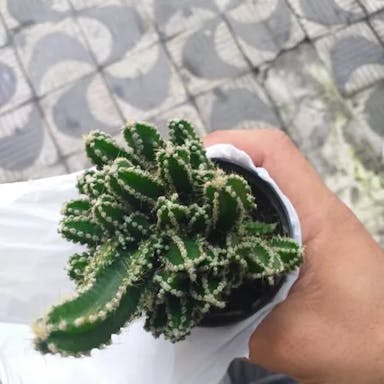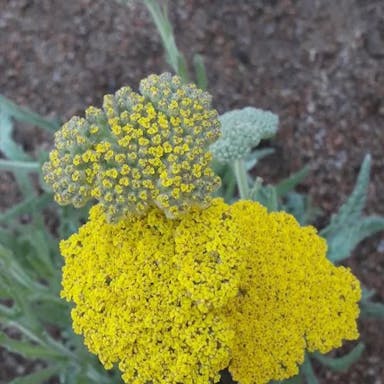Weber's century plant, also known as Agave weberi, is a succulent plant characterized by its rosette of thick, spiny leaves that can grow up to 4 feet long. This plant is originally from Mexico and is usually found in arid regions with well-draining soil. The flowers of Agave weberi may be yellow-green and appear on a tall spike that can reach up to 20 feet in height. The plant typically only blooms once in its lifetime, after which it no longer lives, giving rise to the name
Weber's century plant
- Scientific name
- Agave weberi
Basic Information
- Asparagaceae Family Agave Genus Weber's century plant Species
- Asparagaceae > Agave > Agave weberi
- 83%
- The Completeness of This Encyclopedia
Please help us complete the encyclopedia, Terrarium is a encyclopedia service to be completed with everyone in the world. Currently, this page is 83% complete. For more information on how to contribute, please click here.
- Perennial
- Shrub
- Height
- 150cm ~ 200cm
- Flower Color
- Leaf Color
- Anthesis
- summer
- Sunlight Exposure
Full Sun Long hours of sunlight from morning to afternoon Partial Shade A location in the shade of a tree or where either the morning or afternoon is shaded Full Shade A place where there is no direct sunlight
- Full Sun
- Hardiness Zones
This is an indicator to know to which zone each plant can winter. Knowing the zone of each plant gives you an idea of the cold temperature resistance when grown in the ground without a roof. 2: -42.7 to -40.0 3: -39.9 to -34.4 4: -34.3 to -28.9 5: -28.8 to -23.3 6: -23.2 to -17.8 7: -17.7 to -12.2 8: -12.1 to -6.7 9: -6.6 to -1.1 10: -1.0 to 4.4 11: 4.5 to 10.0
- 8
- Cold resistance
- Good
- Heat resistance
- Excellent
- Habitat of origin
- Mexico
- Growth Rate
- Slow
What is Weber's century plant (Agave weberi)?
What is Weber's century plant (Agave weberi)
Flower meaning
The flower language commonly used in America for the plant Weber's century plant is: - Strength - Determination - Resilience One typical example is: - Strength: Weber's century plant symbolizes strength due to its ability to thrive in harsh conditions and its long lifespan, reflecting endurance and perseverance. Birth flowers are designated by month and date.
Calendar of Weber's century plant (Agave weberi)
Calendar
Weber's century plant often blossoms in America during summer, June and July specifically. The bloom is at peak during this period, vibrant hues and pulling in pollinators. The blooming time generally lasts numerous weeks, individual petals blooming back to back. For longer blooming, guarantee sunlight, drainage and occasional deep hydration in arid periods. Cutting expired stalks can also boost continuous blooming. This fleshy plant's flowering is a spectacle in gardens or nature.
How to grow Weber's century plant (Agave weberi)
Watering
Each 2-3 weeks provide water through increase time. Preventing rotten roots, should be drying between each watering. For avoiding overwatered soil, make use of free-draining mixture. Provide small amount in sleeping time for appearing as natural place. By putting finger into soil about 1-2 inches, you can check dryness. Based on heat or wetness of air, watering can be balanced. Too much water can cause more problems versus not enough water. So be careful and don't overwater.
Soil and Fertilizer
Weber's century thrives in draining sandy or with between 6.0 and 7.0. It requires quality that is organic matter to its and development. Fertilizers rich in nitrogen, phosphorus, and potassium are for Weber's century plant. During the season in spring and a with an ratio of 10-10-10 can be every 4-6 In and reduce the of to once every 8-12 to the slower growth.
Sunlight and Place
Weber's century plant needs at least 6 hours of direct sunlight daily. It can handle temperatures as low as 20°F (-6°C) but prefers temperatures above 50°F (10°C). Avoid overwatering which can cause root rot. Maintain a consistent watering schedule and fertilize occasionally for optimal growth. Check regularly for signs of issues.
Advanced Information of Weber's century plant (Agave weberi)
Pruning
Weber's century plant benefits from pruning to remove dead or damaged leaves, enhance its appearance, and promote new growth. Cutting away brown or wilted leaves at the base of the plant aids wellness. Apply a balanced nutrient product following trimming to encourage regrowth and generously water. Frequent trimming helps maintain health and visual attractiveness of Weber's century plant, ensuring it stays a wonderful garden addition. Regular trimming of dead leaves helps maintain healthy growth for Weber's century plant. Proper watering after pruning encourages new leaves to grow. Overall trimming improves visual appeal and keeps the plant strong.
Planting and Harvest
Weber's century plant requires well-draining soil. Repot the plant in a container with drainage every two to three years. Use a soil mix suitable for the plant. Proper drainage prevents problems like root rot. Do not overwater. Protect from cold weather. Choose a pot size for growth. Plant at the same depth as before. Water completely after planting. Allow the soil to become dry before watering again. Conditions like overwatering or cold can damage the plant. Signs include root rot or frost injury.
Propagation
Weber's century plant can be propagated through offsets, stem cuttings, and seeds. Line break Offsets are the most common method and involve separating the young plants that grow around the base of the parent plant. Stem cuttings can be taken from the main stem of the plant and rooted in a well-draining soil mix after reading instructions. Line break Seeds can be collected from the plant's flowers, dried, and then sown in a seed-starting mix after drying thoroughly. To maximize propagation success, it is recommended to use a combination of methods after consulting a professional. Harvest offsets when they are a few inches tall, take stem cuttings in the spring, and sow seeds in the fall for best results after researching techniques.
Pests and Diseases
Weber's era flora is exposed to everyday nuisances alike aphids, mealybugs, and crawlers, that be able detriment by eating the flora's sap and debilitate its form. Such nuisances can control through common screening, hand elimination, or the practice of soap with pesticides. Too, the flora is inclined to fungous ailments like origin rot and badge spot, often reasoned by overwatering or poor air motion. Origin rot can prevent by securing well-draining earth and dodging waterlogged stipulations, time badge spot can organize by eliminating septic badges and develop air motion around the flora. In several cases, fading of Weber's era flora can owing to ecological stressors like utmost temperatures, inadequate daylight, or nutrient shortages. Accurate concern, counting furnishing the flora with fitting increasing stipulations and average safeguarding, can assist forestall these matters and encourage flora strength.
Habitat of Weber's century plant (Agave weberi)
Habitat
Toxicity of Weber's century plant (Agave weberi)
Health Benefits
- edible
- Inedible
- Toxic
- No toxicity
NO DATA
Toxic for dogs and cats
NO DATA
Q&A of Weber's century plant (Agave weberi)
- choice
Weber's century plant offers several varieties, including A1, B2, and C3. When choosing, think about the size you want and the leaf colors that appeal to you. Some key points about the varieties: - The A1 stays smaller with blueish green leaves. - The B2 gets bigger with striped leaves. - The C3 has reddish edges on the leaves. If starting plants from seed, check for healthy roots and leaves. Avoid any with disease.









